Growing a mini succulent such as Haworthia can be both rewarding and beneficial.
Not only are they aesthetically pleasing, but they are also known to offer some pretty impressive ailment remedies. These include assisting in dampening coughs and healing skin rashes, sunburns, and other burns to name a few.
But, what to do for haworthia turning purple or red?
Well, it is one of the most common issues that growers run into when nurturing them is when they turn a deep red/purple color.
There are many reasons that this can occur, such as poor soil drainage, overwatering, and sun stress, among others.
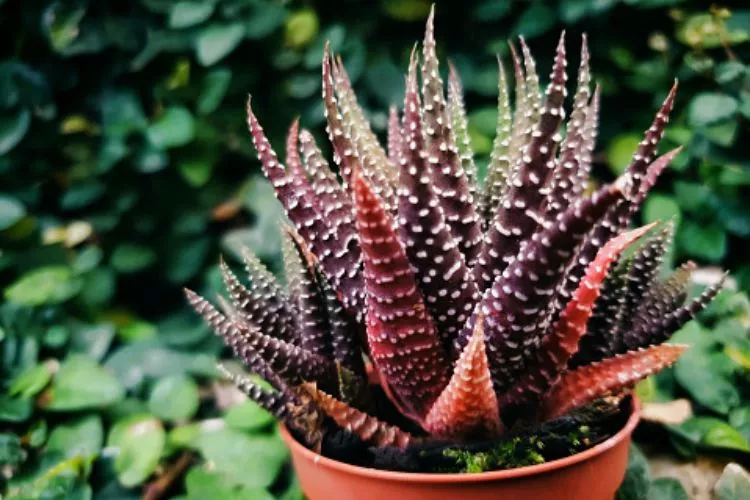
Thankfully, the majority of the causes can be corrected. It’s just a matter of correctly identifying the problem and taking action to fix it.
In this article, we’ll go through all of the common issues as well as offer solutions to help ensure that your haworthia plant can become healthy and thrive again.
Table of Contents
Why is my Haworthia turning Purple (or Red)?
When a plant such as Haworthia becomes discolored, it’s usually a sign that it is under some kind of stress. The plant produces a reddish purple pigment called anthocyanins which assists in the protection of it against certain stressors.
In the case of Haworthia, there are 5 main reasons they can start turning deep red/purple. Of course, there may be a couple of other minor causes, but they are usually propped up by one of these major issues.
Furthermore, some problems can be a lot more damaging than others.
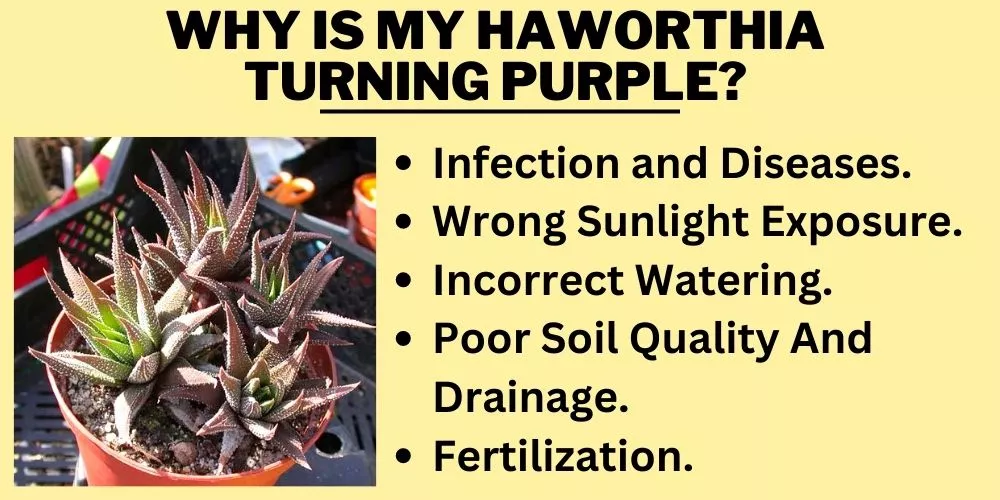
Also, compromising circumstances such as poor soil can cause a domino-like effect if left undiscovered. Let’s look at all the most common stressors in a lot more detail.
Once the issue relating to the plant can be identified, the solution can be implemented to help correct it.
Infection and Diseases
Haworthia plants can contract a couple of different diseases from as many sources. However, root rot is the only infection besides the common fungal disease that will make the plant turn purple.
Most fungal diseases can be brought on by overhead watering, overwatering altogether, and poor air circulation. Watering a succulent such as Haworthia from above (overhead watering) makes the leaves wet.
The excess moisture usually nestles itself in whatever crevice it can find and sits there stagnant. After being left there for an extended period, mold will form and start to build up and stress the plant. The plant will produce anthocyanins as a defense mechanism.
Poor air circulation can occur when a plant isn’t allowed enough space to breathe, especially in humid conditions. Mold forms in a similar fashion as when watering from above occurs.
The moisture becomes trapped after a short period. The fungal infection can take hold.
Overwatering is the basis of many problems. Especially root rot and even more so when coupled with poor soil drainage. If a plant receives too much water at once and isn’t allowed to drain, the roots will sit in the stagnant water and rot. If root rot is left unattended, it will spread from the roots to the tips and kill the plant.
Quick Fix
- Avoid overwatering. Check moisture content routinely and only water when required, not according to a universal timeframe.
- Fungal Infections can be treated using fungicides. Determine the infection and use the correct fungicide for that illness only. Neem oil is a great natural fungicide for sooty mold.
- Resolving root rot will require the plant to be removed from its pot. If the roots are brown/black, mushy, soft, and smelly, they must be trimmed. Any damaged roots need to be carefully pruned away and discarded well away from any other plant or compost to avoid the spread. Repot the plant with fresh potting mix and nurse it back to health via slow watering and care.
Wrong Sunlight Exposure
Haworthia is generally found in more protected spots within their natural environment. So, it’s only natural to ensure they aren’t placed in direct sunlight.
When exposed to excessive sunlight, the Haworhia will become stressed and release their anthocyanins to protect themselves. As a result, their leaves will start to fade to a reddish/purple color before taking hold of the plant.
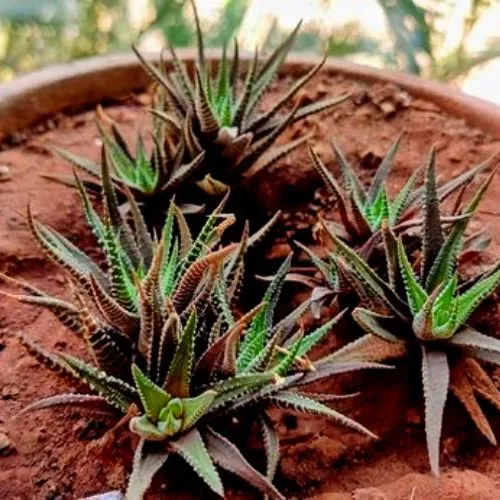
Quick Fix
Although Haworthias look great with a slight tinge, exposing them for too long under direct sunlight can damage them. The partial shade suits them best; luckily correcting this problem is as simple as moving them. Aim to allow them around 4-5 hours of indirect sunlight earlier in the morning.
That way, the sun’s heat won’t have as much sting compared to later in the day. These plants are usually grown in containers and can be easily maneuvered around according to the amount of sun a specific location might offer.
Incorrect Watering
Incorrect watering is one of the biggest issues regarding a succulent. These plants take in moisture and store it in their stem and leaves for later use.
Furthermore, they can go for days without water and not show any negative effects due to the deficiency. This makes their intake a little deceptive.
On the one hand, If a Haworthia doesn’t receive enough water, it can dry out and produce anthocyanins as they stress from the lack of moisture.
In contrast, too much water causes the same visual result; only the excess moisture can bring on root rot. This occurs when the amount of oxygen underneath the soil is choked out by the excess water.
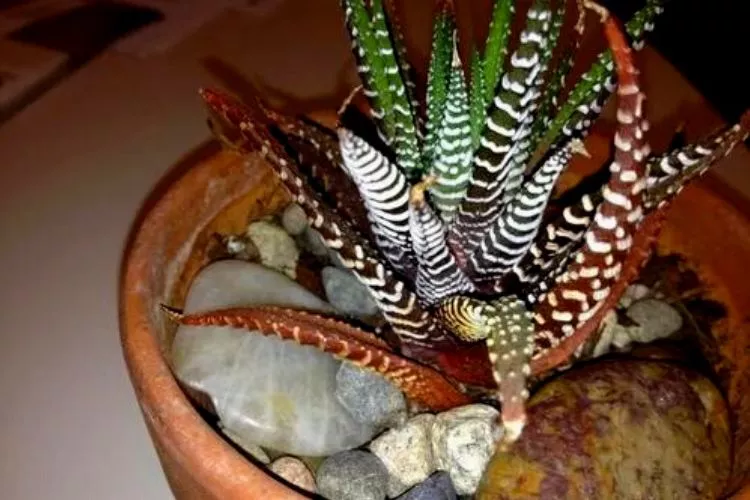
Additionally, poorly draining soil prevents water movement, which leaves water soaking around the root system. The roots are sitting in stagnant water. As the roots don’t get any relief from the moisture, they will begin to rot out, which can spread up through the plant if undetected and/or corrected.
Quick Fix
- The soak and dry method work best. Simply soak the top 2 inches of the plant’s soil and let it completely dry before soaking again.
- Always check the condition of the soil before and after each time they receive water. As mentioned, too much water can have serious ramifications.
- Never water the leaves from above; instead, only at the base of the plant where the stem meets the soil.
Poor Soil Quality And Drainage
Poor soil quality and drainage can single handedly ruin a plant, especially a succulent such as Haworthia. Throw excess water into the mix, and the plant can almost be assured of big problems. These plants need good drainage, or the water will stagnate and clog the soil.
As a result, the roots will pretty much bathe in water without any way of having access to oxygen down there. This leads to root rot which stresses the plant out and makes it again release its anthocyanins to help it try to survive.
Sadly, root rot needs a complete pot and soil overhaul, so its struggle will be no avail. Adequate drainage can be obtained by ensuring the right growing medium as the plant is potted.
Quick Fix
- Haworthia prefers sandy, gravelly soil. It’s best to use a cactus growing mix and blend in some perlite, pumice, or aquarium gravel to assist with water movement. The cactus mix generally has all the important nutrients which ensure the plant isn’t missing out on anything.
- As mentioned, if a Haworthia becomes discolored due to poor drainage, the best fix is to remove it from its pot. Then, gently rinse away the old soil and add a fresh mix to the pot before replanting.
Fertilization
All plants, including the Haworthia, receive their nutrients, enabling them to grow from their soil or via fertilization. A lack of nutrients will make the plant stress and release its anthocyanins.
An undernourished plant will look frail and limp and present a reddish purple hue. Thankfully, feeding a Haworthia too little or too much doesn’t have serious ramifications and can easily be corrected.
Quick Fix
- Aim to fertilize once a month from spring to early fall. Avoid fertilization through mid fall to winter as the plant will be dormant. A dormant plant won’t take in the nutrients and can toxify the surrounding soil as they sit around unused.
- Use organic fertilizer where possible and avoid chemical types. We generally try to go organic wherever possible and have seen no difference between the 2 types. Therefore, we believe nature is always better and safer.
How To Prevent Haworthia From Turning Red or Purple?
Aside from the problems and solutions that we have just gone through in extensive detail, some other methods can be used to help prevent the issues from occurring in the first place.
These types of actions should be seen as general maintenance and setup measures. As long as the plant is grown with its specific conditional requirements in mind, there shouldn’t be any reason for stressors to occur.
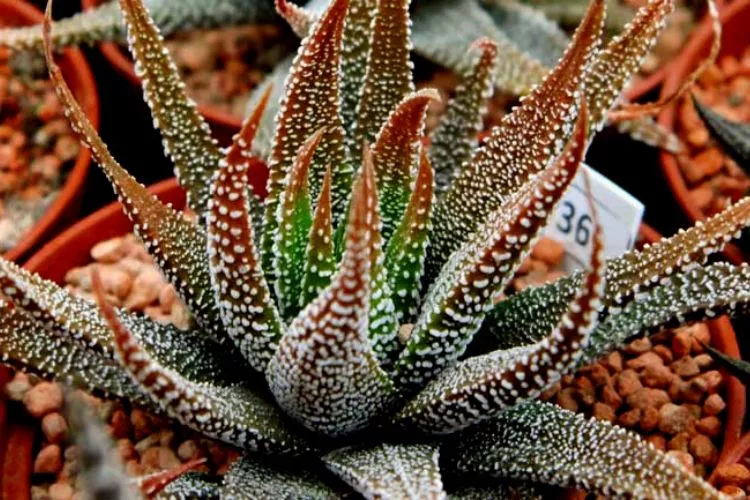
- Make sure that a Haworthia is suited to your lifestyle and home. This does sound a bit strange, but some plants just won’t grow everywhere and anywhere.
- For example, you may live in a dark apartment without windows and/or natural light. They may require some form of artificial lighting to mimic the sun. Light deficiencies can discolor a Haworthia.
- Think about any possible extreme heat or chills the plant may suffer from and ensure they are well protected using windbreaks or roof coverings such as shade sails or porches.
- Alternatively, move them inside, away from any harsh environmental pressure they could succumb to at the time. Extreme temperatures can induce discoloring within these types of plants.
- Poor drainage and excess water are the biggest issues when growing succulents. We can’t stress enough the importance of first setting up your Haworthia with adequately draining soil and then watering so that you allow the water to dry before adding more moisture. Simple tweaks can fix most other issues. These 2 can cause serious headaches if not planned to perfection.
How do you know if haworthia is dying?
Like all plants, the Haworthia presents visual signs to help us understand the state of its health and the condition in which it is. When their leaves begin to lack plumpness and droop, it’s easy to assume that the early warning signs of an underlying issue begin to show. How can you tell if the plant is dying, though? Let’s look at the signs…
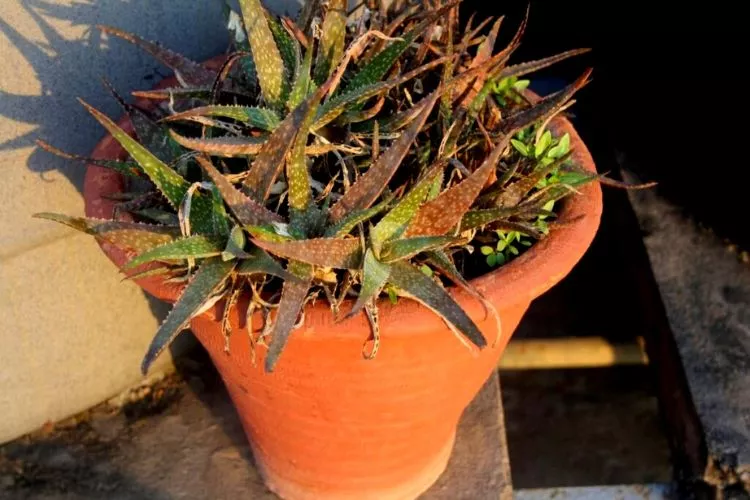
- Leaves – When hanging onto a thread, the leaves of a Haworthia will start to discolor. They can first turn reddish/purple as they release anthocyanins. If the cause is left undiscovered, the leaves will start to turn yellow and then brown. After some time, they will turn mushy and black as they are close to dying.
- Stem – The stem has similar characteristics to the leaves, except they tend to begin their transformation a little earlier. Additionally, the stem will become brittle and offer less support to the leaves as it becomes weaker.
- Roots – The roots are generally the first to go and spread up through the plant. It’s often difficult to check on the condition of the roots as they are under the soil. If you notice big changes in the upper areas of the plant, it’s best to remove it from its pot and gently rinse away the roots. If they appear black and mushy, then the plant will not survive. If there are still white or green roots, then there is still hope.
If the crown is closed and shriveled up dry, then it’s more than likely dead.
How do I bring haworthia back to life?
If you have a Haworthia plant and have done all the right checks on it to confirm that it’s still alive, you can do a few things to nurture it back to full health. The effectiveness of these steps can only be decided by the amount of damage caused to the plant in the first place. Sadly, some cannot be revived. Here’s what you can do:
- Prune away any damaged leaves, limbs, or roots. This may require removing the plant from its growing container, rinsing the roots, and replanting in fresh soil.
- Plant in a better location than its previous one. Allow it access to indirect sunlight, away from extreme heat and/or chills and winds.
- Water only when they become dry. Succulents hold water, so they won’t dry out if left for short periods without moisture. Soak the top 2 inches and let it completely dry out before applying any more.
- Treat any pest infestations or diseases with natural pesticides and/or fungicides.
- Avoid further stressors, go through this guide, and give them everything they need to ensure a stress free life. Keep a close eye on the plant for at least the first 2 weeks and allow them the best possible conditions to survive and thrive.
Frequently Asked Questions (FAQs)
Do haworthia like the full sun?
Funnily enough, some Haworthia can be found in the wild growing under full sun conditions, but most are nestled in areas protected from the elements. Ideally, these succulents prefer 4-5 hours of indirect sun earlier in the day. Keep them shaded for the rest of the time.
How often should I water haworthia?
There is no universal watering schedule for Haworthia. This is mainly because they can be different sizes, shapes, ages, etc. The best watering method is to soak and see. This can be achieved by soaking only the top 2 inches of soil at the base of the stem. Allow that water to dry completely before reapplying.
Do haworthia like small pots?
A Haworthia can be grown in a pot as small as 3-5 inches. As long as the soil drains well and the pot has drainage holes, they will grow just fine. Check in on the plant now and then, as they can suffer from root balling once they become too large for their pot.
Does haworthia like to be misted?
Misting is not recommended for any type of succulents. In the wild, succulents are grown in arid environments, so adding a humidity factor to their growing area can cause mold to form. The moisture on the leaves fills the crevices and sits stagnant. The stagnant water causes mold. Mold can destroy the plant if undetected or corrected.
How do you know when haworthia needs water?
The best way to check the moisture content of Haworthias soil is by simply sticking your finger down the side of the stem into the soil. If the top 2 inches are wet, it shouldn’t be allowed more water. Only apply water when that top 2 inch dries out.
Conclusion
The beauty of these types of succulents is that they will offer clear visual signs to show that they are under some stress. P drainage and overwatering can lead to a fast death of a Haworthia. Poor sunlight, excess heat, and poor fertilization are easier to correct and save the plant.
Just go through the process of elimination, work out exactly what the plant is suffering from, and take action to fix it. We hope that this article has been helpful, and as always, happy growing!


